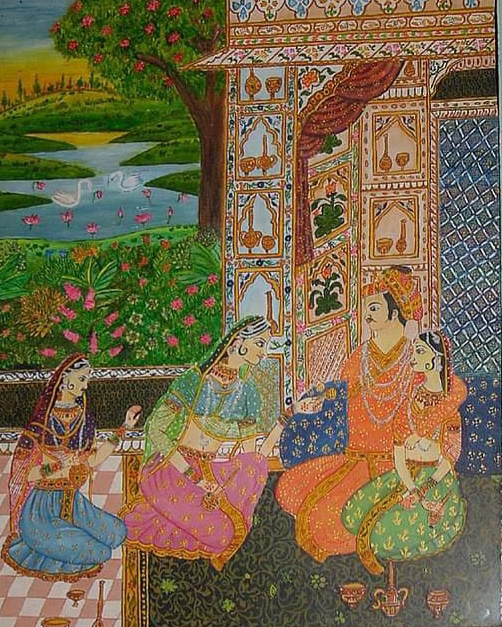A glimpse of rural Rajasthan
'Padharo mhare desh' - We have been exposed to various glimpses of Rajasthan tourism through the media. The forts, palaces, sand dunes, the ghumar dance, sweets, rich tradtitonal crafts and costumes etc. How about looking at a different perspective? Rural Rajasthan. Haven't we all heard, 'India lives in villages' ?
Rajasthan is my native state but like most Mumbaiites or should I say urbanites, I have been exposed to Rajasthan only as a tourist or wildlife enthusiast and have seen the popular glimpses as depicted in the media. This time my journey to Rajasthan in search of the elusive and magnificient bird, the Lesser florican, took me to rural Rajasthan. I have often written on my wildlife sojourns across India, but this time I feel like sharing the story of the rural life that I saw, as we travelled through fields in search of our bird. This is a critically endangered bird and only a few hundred are alive. It is usually seen during the breeding season in the agricultural fields of moong and jowar. Whether we eventually found our bird, will be part of another story.
We went to Sonkhaliya, a village 40 km from Ajmer city. Ajmer was the capital of the Mughal Empire. Sonkhaliya has a population of 3000 people and the Sonkhaliya panchayat comprises of 6 villages with a total population of about 6000. Farming and cattle rearing is the main occupation, like most of rural India. We stayed at a guest house with basic amenities, which too were in disarray I must say, located at a petrol pump on the highway that leads from Ajmer to Sonkhaliya. The guest house owner was rich man and educated as well, yet he found no need to upgrade the guest house beyond basic facilities, simply because there are no takers. And yet the place charmed us. The room was big and had numerous windows and each window opened to huge agricultural fields, which ended only at the horizon. In our 3 day stay, we scourged through almost 150 km, traversing through village settlements and agricultural fields in search of the bird. This was also a first hand look at the rural life.
The villagers wore the traditional Rajasthani costume - the males wearing a really huge turban on the head, a kurta and a dhoti tied right upto the mid-thigh level. Probably to keep it from soiling while ploghing the fields? The women folk wore colorful chaniya cholis and while the costume often kept the midriff completely exposed from the front, it did not in the least appear like arousing lust. The faces of the younger women were covered with ghoonghat. Children often looked at us in awe and we saw them running around or whiling their time playing marbles. Interestingly, we never saw anyone dressed in tatters or completely naked, which made me feel good. Hopefully, most of them are able to afford at least covering their body. When not ploughing the fields, the men were ususally sitting idle. There was also a sizable population of elderly men and women, but there seems to be no concept of retirement from work. Women folk worked in fields as well as home - the usual cooking and washing. However, another heartening aspect was the presence of tube wells all over and we did not see women folk carrying multiple pots of water on their heads over long distances. Some progress this!! Young men and women and young boys and girls also led cattle - sheep, goats, cows, buffaloes and they always had with them bottles of water in what looked like woollen cases. Must be some way of keeping it cool I guess; and small packets of food packed in lunch boxes. And they seemed to be singing and enjoying, the way we read in English books as kids. We did not see a single overweight individual or kid....the bane of urban living. Afterall, there is lot of physical hardwork. Also, everyone wore footwear, including women - again giving me a heartening indication that hopefully most people were able to afford the basic necessities. Amen!!!
Another sign of development was the presence of mechanised tractors which also had water sprinklers and hoses attached. We did not see anyone ploughing the fields with axe or cattle. The houses too were concrete structures and many of them had a signboard in Hindi which read 'xyz family welcomes you to their home'. I did not see any doors or locks !! My guess also is that most people still sleep outside the house on charpois. That has been the culture in Rajasthan as the heat is terrible. After sunset, the nights outside the homes are indeed pleasant and one would really crave to sleep under the sky with the cool and gentle breeze. Of course we did not go to the villages after sunset' else would have known more about life after end of day.
Now for the most beautiful aspect - the fields. Miles and miles of ploughed and sown land. Moong and jowar are the main crops. Apparently it had rained for 2-3 days in mid-July and the ploughing and sowing had been done. However, rain gods had then deserted them and the worry was that if it doesn't rain in the next 10 days, we might have to plough again. Tiny shoots were coming up from the sowing and in pockets where rain had been better, the shoots were now 5-6 inches tall. A number of tiny birds flitted about the fields singing and feeding all day. We had a great time identifying and clicking them. The cattle were busy grazing and there were charpois in the fields with colroful scarecrows, apparently to keep the neelgais at bay. Neelgais are known to destroy crops. One would often see a family of Grey francolins scurrying over. At dawn and dusk, the quail families - 3 different species could be seen running hither tither. Lapwings are nesting and since they lay their eggs in open fields, they created quite a cacophony with their twee-tee-tee-tee through the day. Peacocks seemed to be family members of the villagers, in fact outnumbering them and now in the breeding season have their full grown plumage. The male peacocks danced in a bid to attract the females; but the moment we tried to take a picture, they showed us their butts!!!! It is easy to fall in love with life there; although I must admit, we are not aware of the difficulties of their lives.
Among other signs of development, there is a primary school but one saw no hospitals or doctors. There was only an occasional stall selling some vegetables and some fruits. Whether the villagers do not consume variety of vegetables and fruits on a daily basis or procure it from Ajmer, I have no clue. But the former seems more likely. Procuring something for daily consumption from a distance of 40 km seems improbable. Jowar and Bajra are known to be staple. Has the digital era touched them at all? Well, I did see the Vodafone and Airtel boards but did not see any villager holding a cell phone. Yes, people other than those in fulltime agricultural occupation, like the owner and staff of our lodge as also our bird guide, used them freely. Again, in the villages I saw no dish TV antennae so that's another blind spot to me. Our lodge owner was proud to have one and kept insisting on switching it on to entertain us. We had to plead with him that we have come all the way from the mad metropolis called Mumbai to enjoy silence and run away from the digital onslaught in our lives. Electricity continues to be erratic. Also saw some young and old men riding bikes wearing the turban and the dhoti. But there were no vehicles outside any houses. So my guess is, the owners must be a few people who are doing well compared to others. But if you thought there was complete solitude and peace all the time, in the absence of any digital onslaught, you are wrong. Right at the crack of dawn, loud music is blaring from different corners. Also it almost seemed as if it is mandatory to play the loudest music possible when driving tractors!!! What do they play? Not the current chartbusters, but those of the 90s and early 2000s. And how do they play the songs, you might ask? Well, on pen drives!!! The tractors have USB ports :) . I often felt like telling them, 'Blessed you are to have this peace of nature. We come here all the way to run away from noise and sound. You know not, how precious silence is, where one only hears sounds of nature and nothing else!! Why do you break it?'.
At the end of 4 days, my heart did not want to come back to this crazy place called Mumbai where we are running after a mirage. My guide told me, 'I will send my son to Mumbai; to you'. I said, 'You are doing well financially and have everything one needs in life- a good house, good food, acres and acres of land. Why do want to make your own son unhappy? He will forget smiling and laughing from his heart for life. Don't punish your own child. His life here is beautiful. What you have here will suffice your family for life, but in Mumbai, no amount of earning and saving is sufficient as you spend a lot of money dealing with stress and the illnesses it brings along. Let him be here, with you. Educate him, but don't push him to Mumbai. Change his mindset, not his life.'
 When lady luck deserts you
When lady luck deserts you


 Neelgai invading the fields
Neelgai invading the fields






Comments
Post a Comment